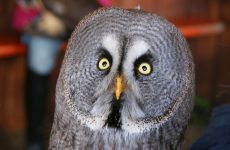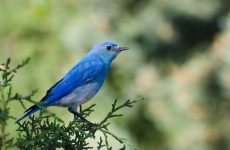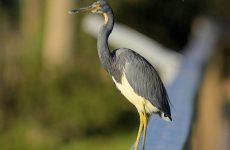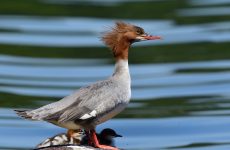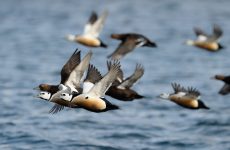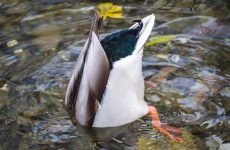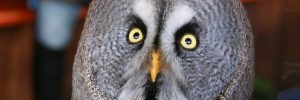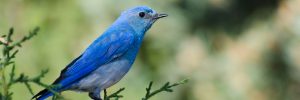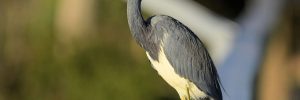If you need help identifying birds with orange heads in North America then you have come to the right place. Get photos, identification help, bird calls, and what you need to know about where you might spot them and at what time of year.
All this information will really help you to identify those birds with orange heads. So take a look and see if you can spot the bird you are looking for.
9 Birds With Orange Heads:
1. Hooded Oriole
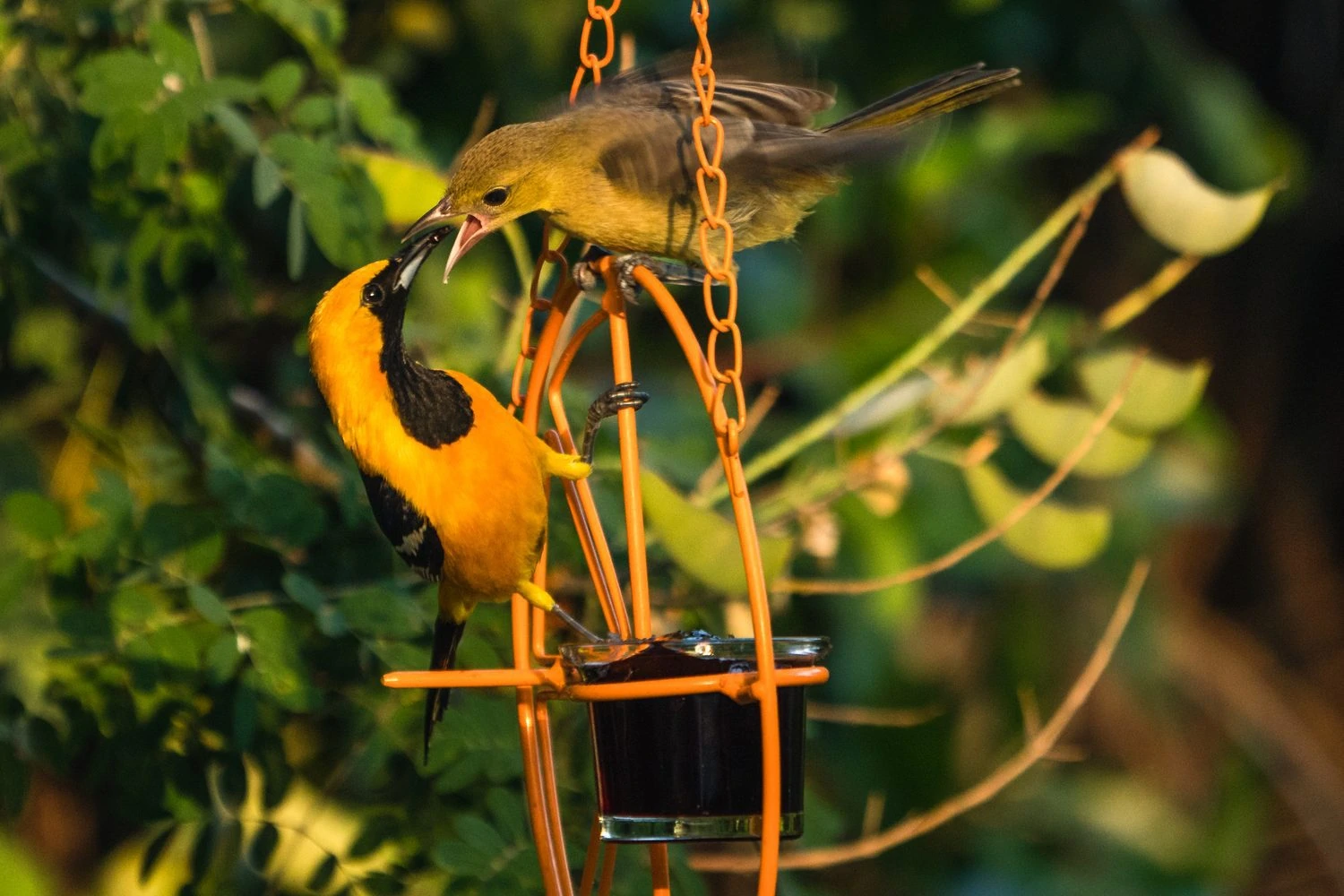
Male Hooded Orioles range from bright yellow to bright orange, with black throats and backs. Females and immatures are more yellow with grayish wings. Females also lack the black face markings that males have.
- Icterus cucullatus
- Length: 7.1-7.9 in (18-20 cm)
- Weight: 0.8 oz (24 g)
- Wingspan: 9.1-11.0 in (23-28 cm)
Hooded Orioles breed in the southern US states, making hanging nests on the undersides of palm fronds. They winter in Mexico, and some remain all year on the Gulf Coast of Mexico and Central America.
Some Hooded Orioles have stopped migrating from southern US states because of the ready food supply from nectar feeders and fruit left out by birdwatchers. They live in dry open areas, especially near palm trees.
Hooded Oriole sounds: The males’ song is a jumbled mix of whistles and warbles. Females’ songs are less complex, and they both have sharp calls.
Nests of Hooded Orioles are high at around 20 feet off the ground and are hanging baskets weaved from grass and plant material.
Attract Hooded Orioles to your backyard with sugar water, jelly, and oranges.
Fun fact: Hooded Oriole males in Texas tend to be orange in color, but those further west are yellow.
2. Spot-breasted Oriole Juvenile
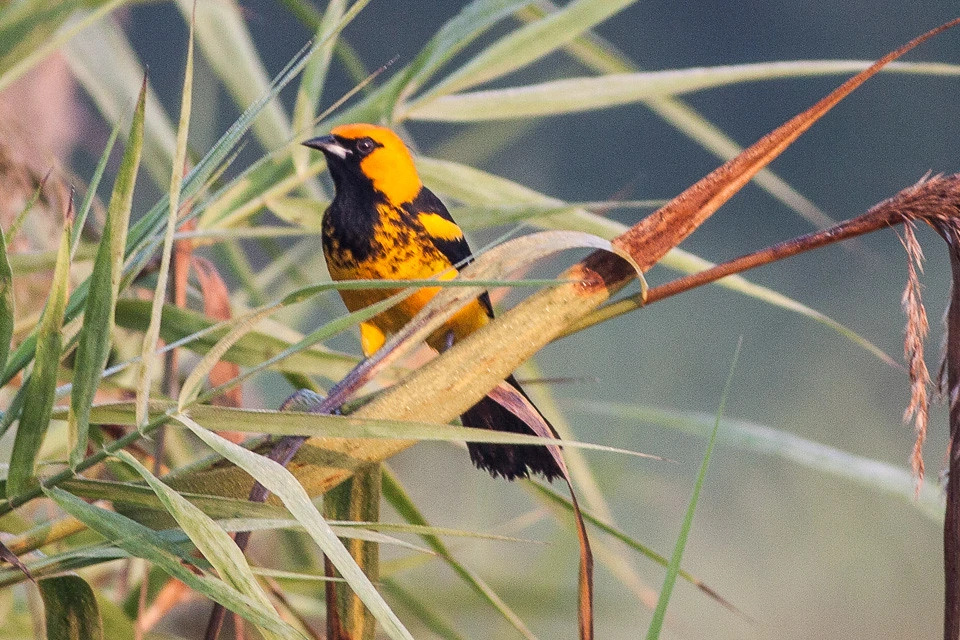
Credit: Ron Knight
Juvenile Spot-breasted Orioles are more yellow in color with dark backs, wings, and tails.
Spot-breasted Orioles are black and orange birds with black spotting on their breast and white on the wing edges. They have black around the face and chest and are black on the back, wings, and tail.
- Icterus pectoralis
- Length: 8.3-9.4 in (21-24 cm)
- Weight: 1.8 oz (50 g)
Spot-breasted Orioles can be found in Florida and along the Gulf Coast, but they are not very common in the US. Instead, they mostly live in Mexico and the Pacific Coast of Central America.
They live in open woodlands and dry scrub and will come to more urban areas.
Spot-breasted Oriole sounds: Their song is a tuneful series of whistles, and their calls are harsh and loud.
Attract Spot-breasted Orioles to your backyard with fruit and sugar water.
Fun fact: Nests of Spot-breasted Orioles are made from plants and fibers weaved into a long hanging pouch from a tree.
3. Western Tanager Male
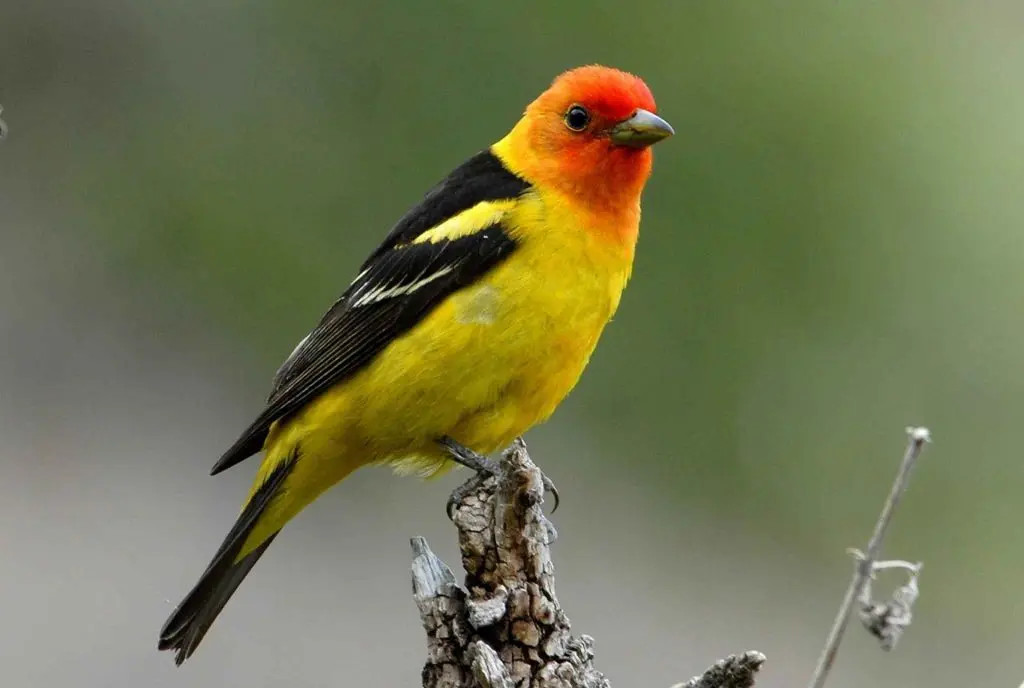
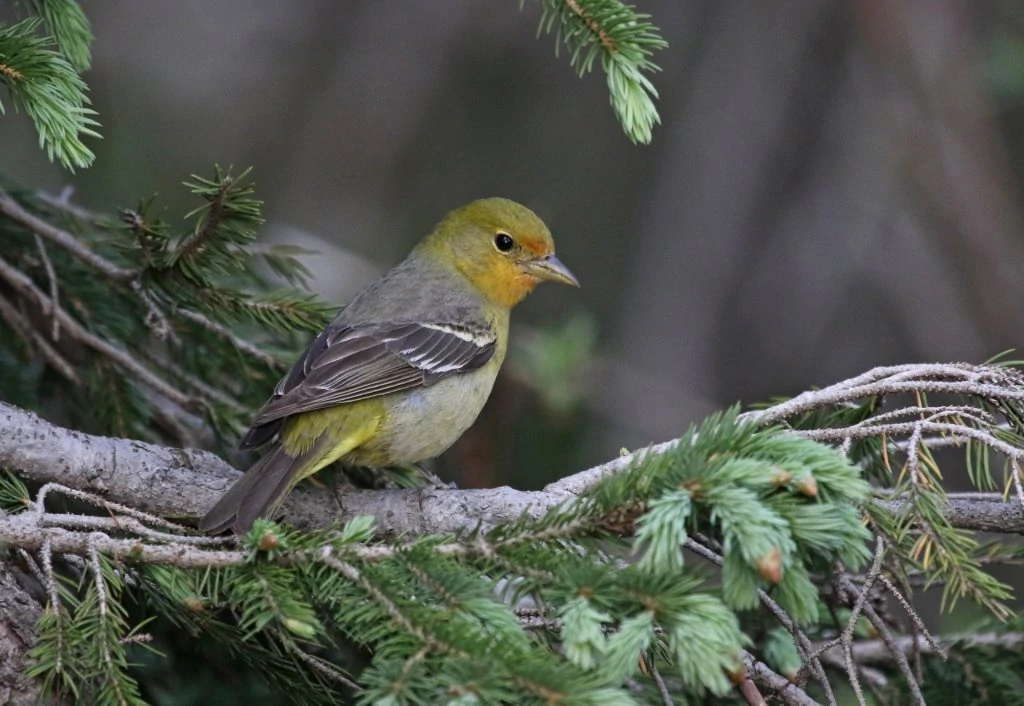
Western Tanagers have a flaming orange-red head, yellow body, and black wings. Females have only red faces, and their bodies are yellow-green.
- Piranga ludoviciana
- Length: 6.3-7.5 in (16-19 cm)
- Weight: 0.8-1.3 oz (24-36 g)
Western Tanagers breed in western US states and western Canada. They can be seen during migration in the east and south of this range. Winter is spent in Mexico and Central America.
You can find Western Tanagers in open conifer forests, but they stay hidden in the canopy, despite their bright coloring. Their numbers are actually increasing in the last forty years.
They eat mainly insects in summer, such as wasps and grasshoppers, and in the fall and winter, they also eat fruit.
Western Tanager Song:
Nests of Western Tanagers are built by females in open areas of trees and are made from large twigs and then roots and smaller twigs to weave them into a sturdy cup shape. The nest is lined with soft grass, pine needles, hair, and other plant materials. They lay around four eggs which take around two weeks to hatch.
Attract Western Tanagers with dried fruit, cut oranges, and other fruits from bird feeders.
Fun fact: Western Tanagers’ red coloring probably comes from eating insects that produce a pigment that they cannot produce themselves.
4. Scarlet Tanager Male
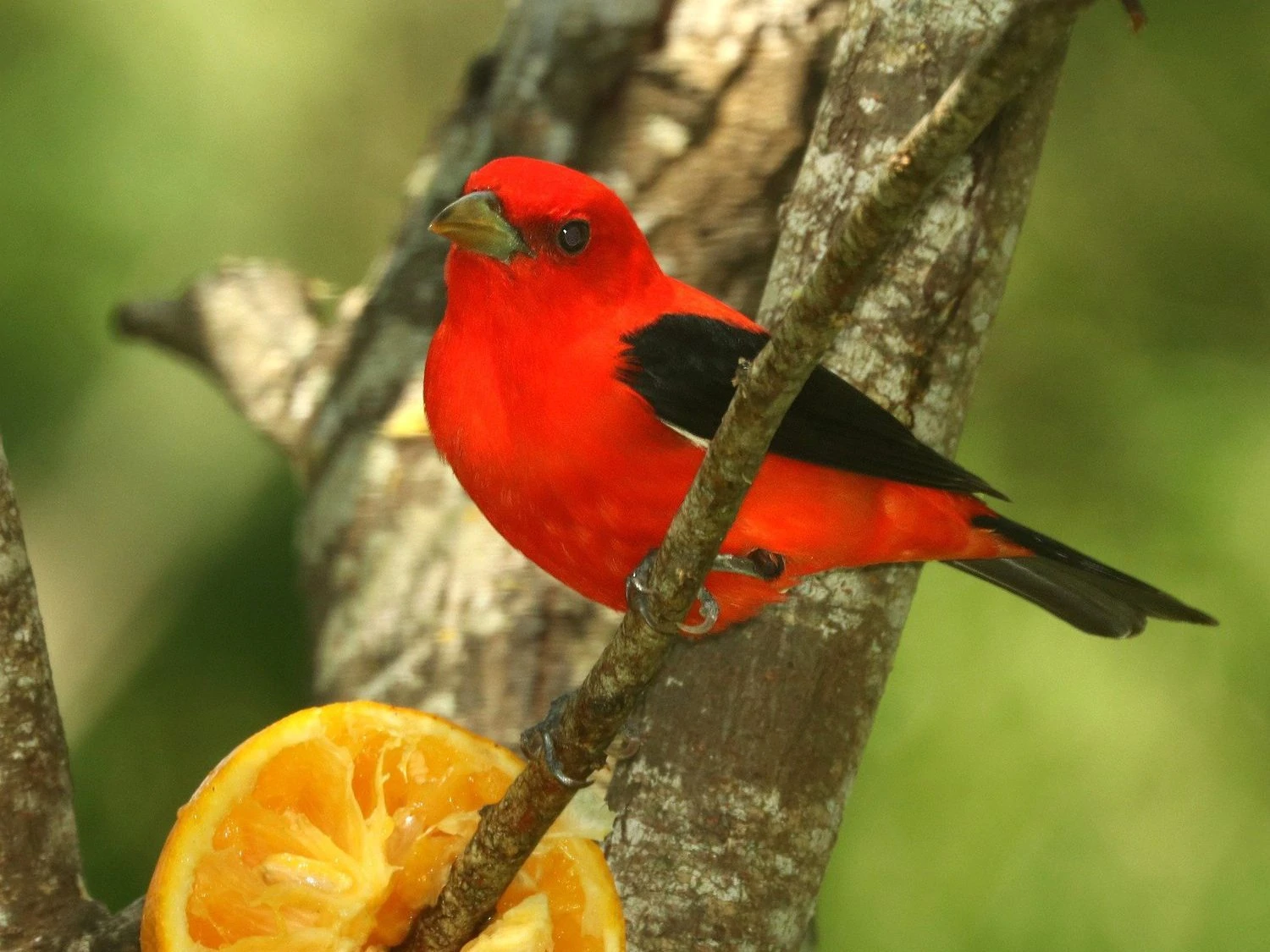
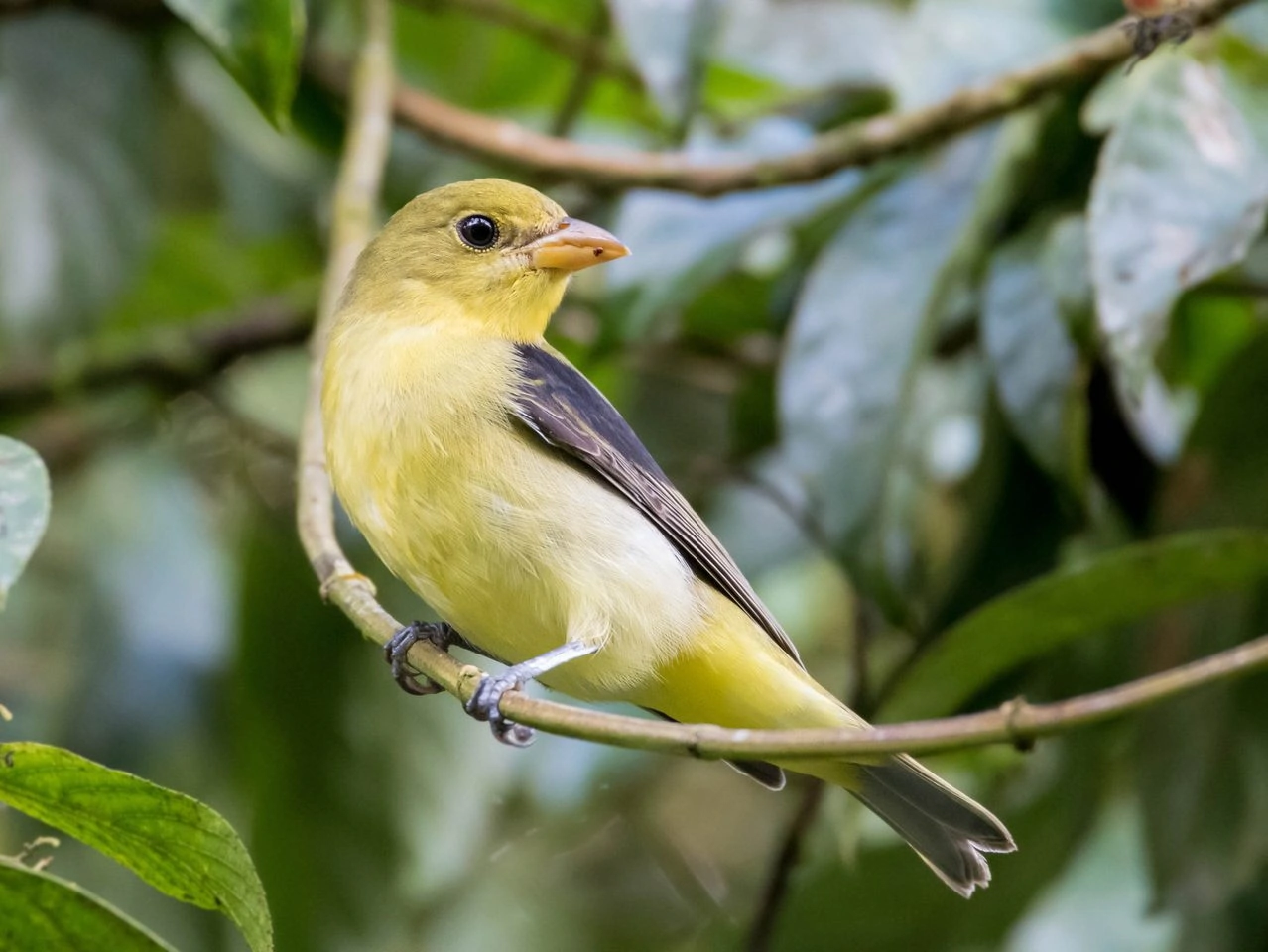
Scarlet Tanagers are bright red birds with black wings and tails. However, in some light, they may look bright orange.
Females are yellow with darker wings and tails, as are the males after molting. Their bills are thick, and they have pretty short tails.
- Piranga olivacea
- Length: 6.3-6.7 in (16-17 cm)
- Weight: 0.8-1.3 oz (23-38 g)
- Wingspan: 9.8-11.4 in (25-29 cm)
In summer, Scarlet Tanagers breed in eastern forests before migrating to western South America. They can be spotted in southeastern states during their migrations.
Scarlet Tanagers can be hard to spot as they stay high in the forest canopy, but you may see a flash of red as they walk along branches looking for insects.
Scarlet Tanager Song:
Nests of Scarlet Tanagers are built by females in only around four days from loosely woven twigs, grass, and plant material. The inside is lined with soft grass, pine needles, and other soft material. They lay around four eggs, which take two weeks to hatch and up to two weeks for the young to fledge.
Attract Scarlet Tanagers by planting berry plants such as blackberries, raspberries, huckleberries, juneberries, serviceberries, mulberries, strawberries, and chokeberries.
Fun fact: Male Scarlet Tanagers have singing battles which sometimes spill over into actual fighting.
5. Rufous Hummingbird
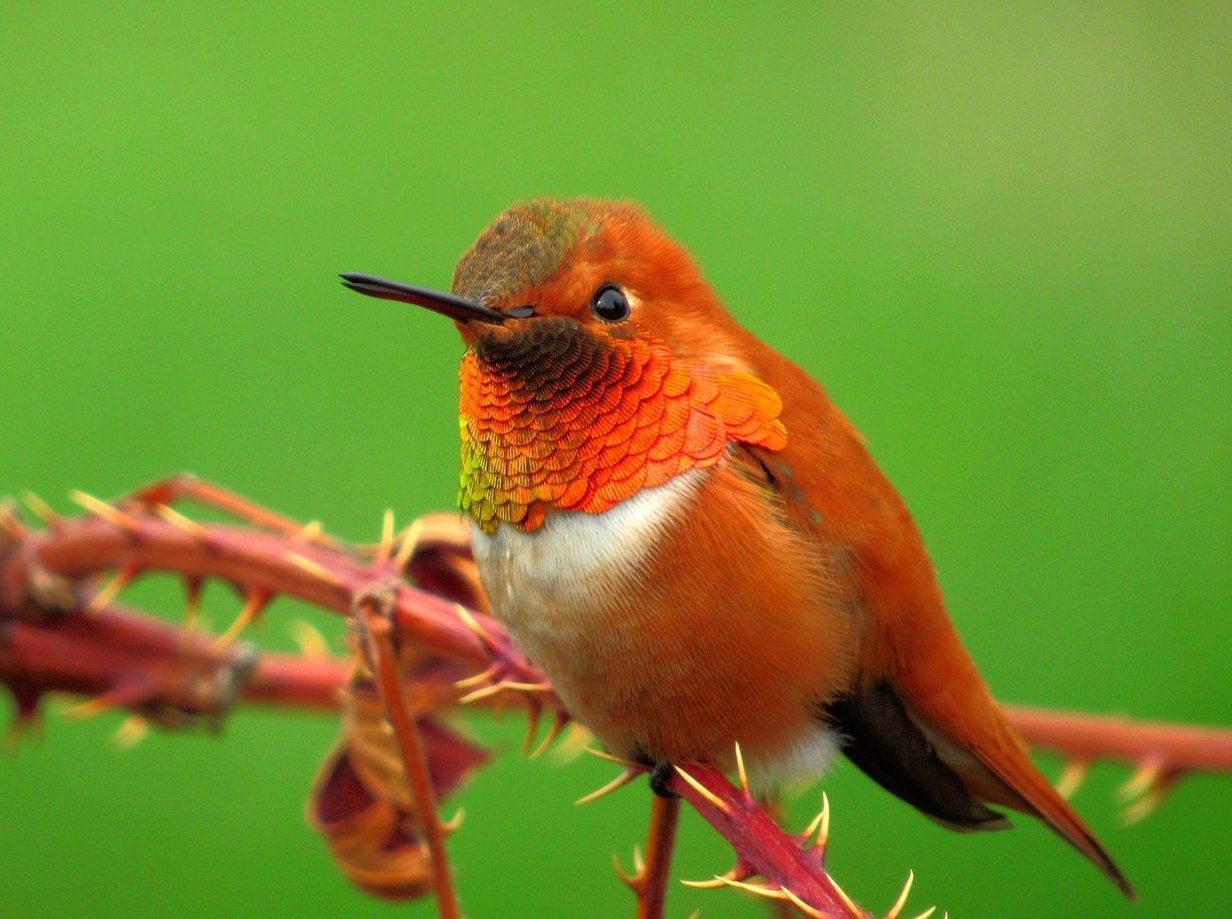
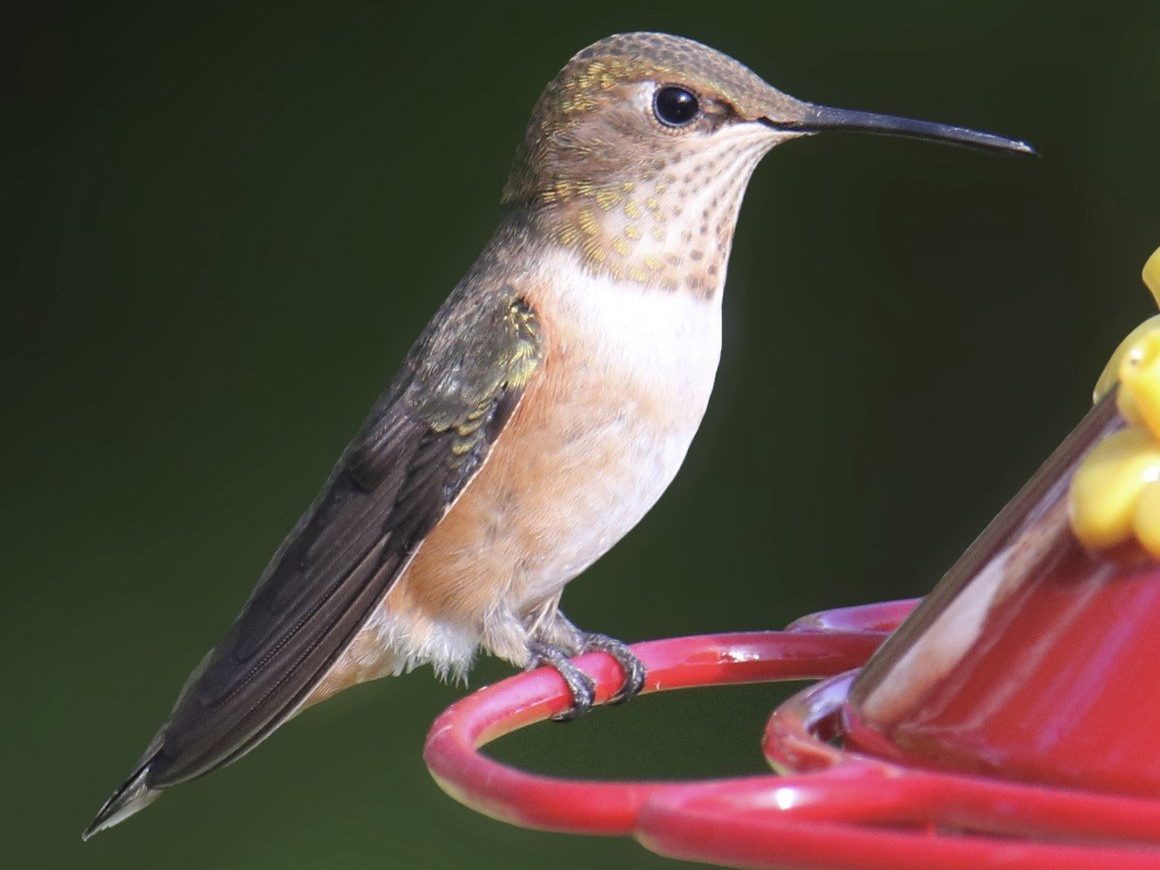
Rufous Hummingbirds are bright orange on the head, back, and belly, with a white patch below the throat and an iridescent red throat in the males. The females are greenish-brown on the back and rusty-colored on the sides with a whitish belly.
- Length: 2.8-3.5 in (7-9 cm)
- Weight: 0.1-0.2 oz (2-5 g)
- Wingspan: 4.3 in (11 cm)
Rufous Hummingbirds are one of the longest migrating birds relative to their size, traveling up to 4000 miles each way. They breed in northwest Alaska and northwest Canada in the summer and migrate down to Mexico and the Gulf Coast for winter.
Migration of Rufous Hummingbirds is north along the Pacific Coast in spring and the Rocky Mountains in late summer and fall. Migration in the spring of Rufous Hummingbirds starts in February, and they usually reach Alaska by mid-April. Migration in the fall is in July and August and ends by October.
A study has shown that Rufous Hummingbirds start their migration earlier and travel north more inland than before.
Rufous Hummingbird numbers have declined by around 60% since the 1970s
Rufous Hummingbirds feed primarily on nectar from colorful tubular flowers and insects such as gnats, midges, and flies. They build a nest high up in trees using soft down from plants and spider webs to hold it together. They lay 2-3 tiny white eggs about 0.5 in (1.3 cm) long. Their habitat is mountain meadows and coniferous forests.
They are very aggressive and chase off any other hummingbirds that may appear, even larger hummingbirds or resident ones during migration. They won’t hang around long during migration but will still chase off most other hummingbirds given a chance.
6. Allen’s Hummingbird
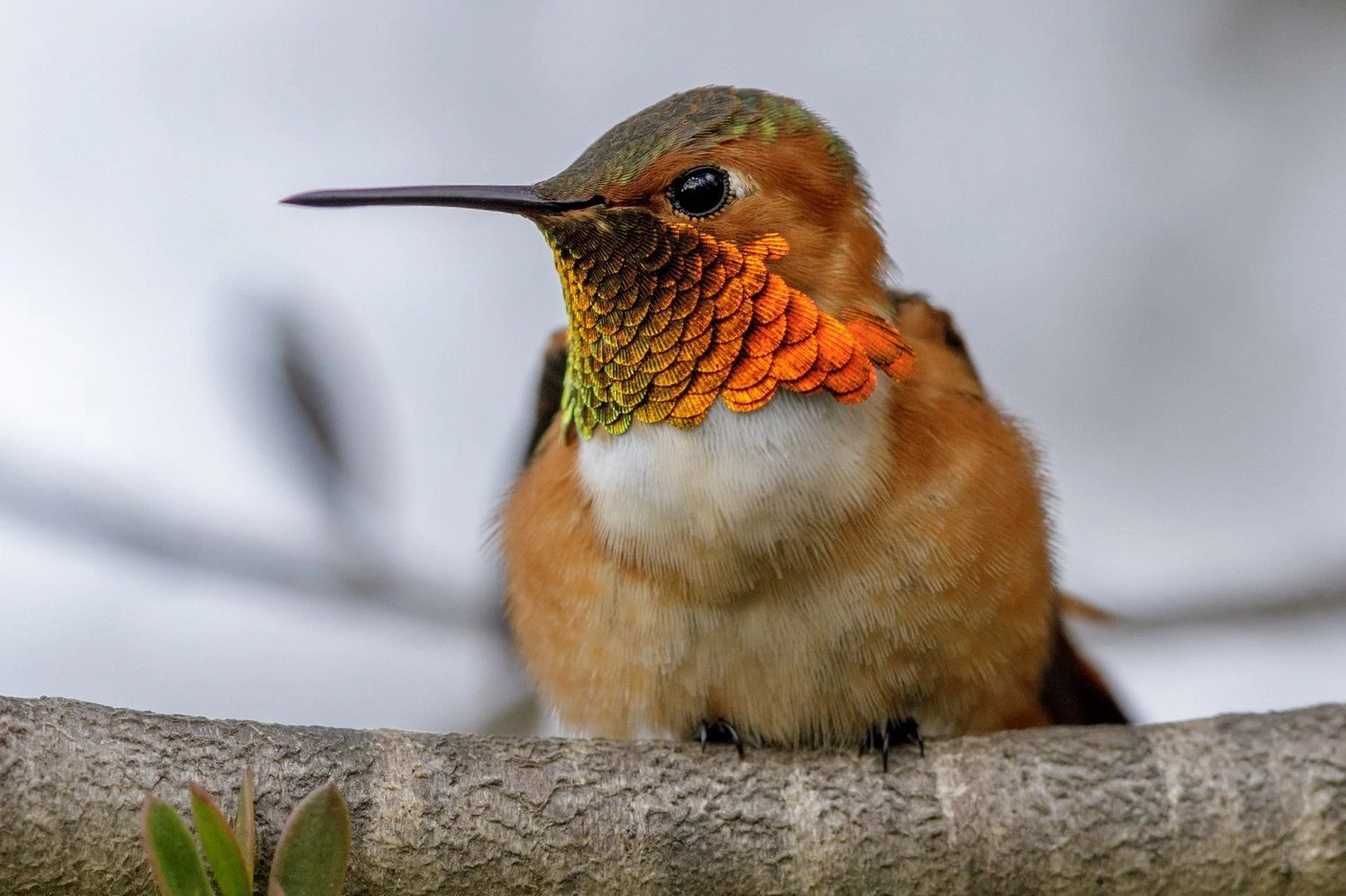
Allen’s Hummingbirds look very similar to Rufous Hummingbirds, so it’s hard to tell them apart in the narrow band of coastal forest and scrub they inhabit between California and Oregon.
Male Allen’s Hummingbirds have iridescent reddish-orange throats and orange heads, bellies, tails, and eye patches. Both males and females have long straight bills and coppery-green backs, but the females lack the bright throat coloring.
- Length: 3.5 in (9 cm)
- Weight: 0.1-0.1 oz (2-4 g)
- Wingspan: 4.3 in (11 cm)
The difference between Allen’s and Rufous Hummingbirds is the narrow outer tail feathers in Allen’s Hummingbird.
Allen’s Hummingbirds build nests near shady streams and have up to 3 broods a year. They spend winter in Mexico and migrate as early as January up to the Pacific Coast in California and Oregon, but they are most common between March and July. Some remain residents all year in central Mexico and around Los Angeles.
7. Altamira Oriole
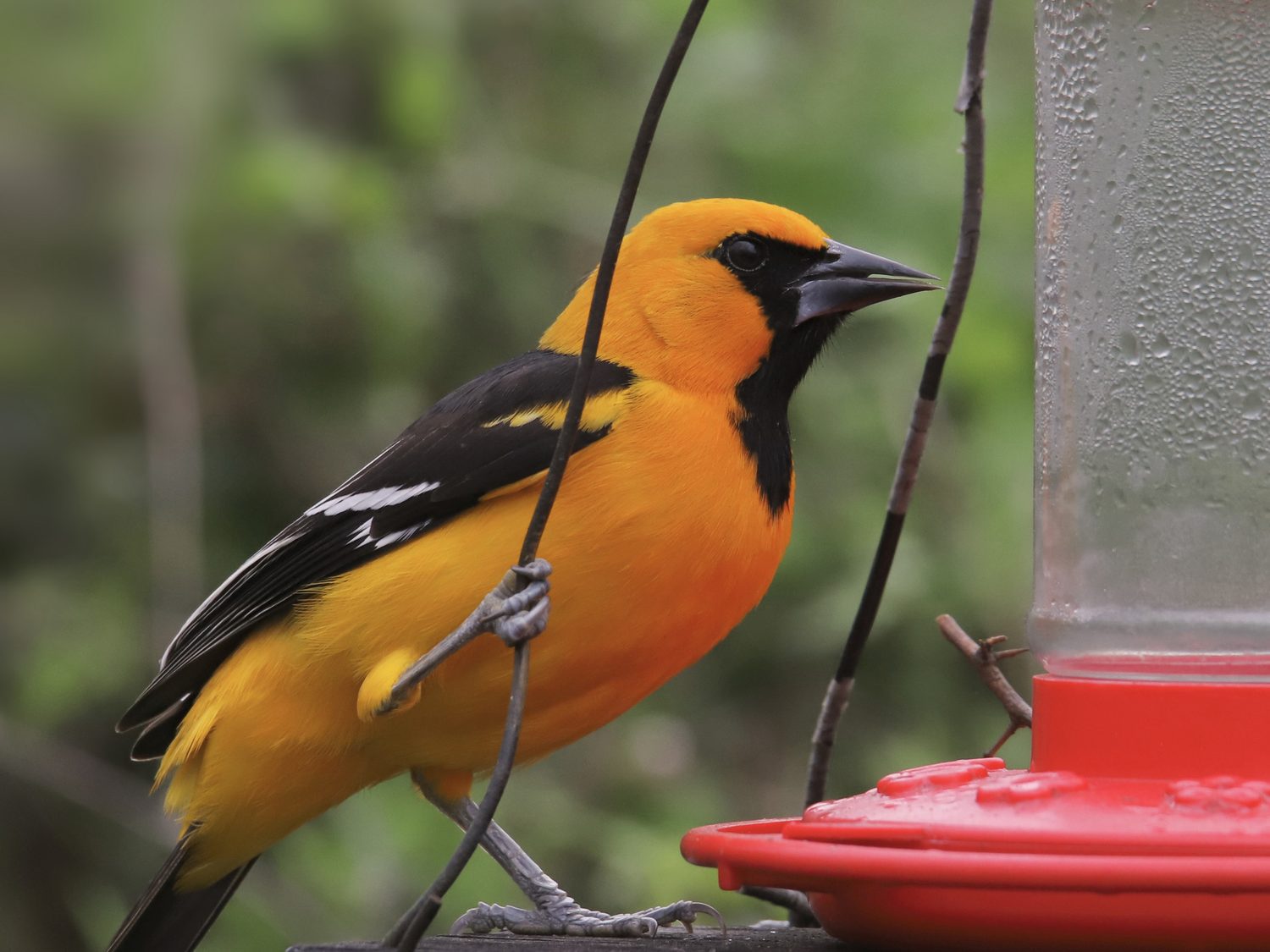
Altamira Orioles are bright yellowish-orange with black backs, wings, and tails. They also have black around the eyes and down the throat. Males and females look the same, but juveniles are more yellow and have olive backs rather than black.
- Icterus gularis
- Length: 8.3-9.8 in (21-25 cm)
- Weight: 1.7-2.3 oz (47-64 g)
- Wingspan: 14.2 in (36 cm)
Altamira Orioles are rare in the US except in the Rio Grande Valley, Texas, and they remain year-round.
Look for them in backyards at sunflower or nectar feeders or in wildlife refuges in southeastern Texas and along the Gulf Coast of Central America. They prefer open woodlands.
Altamira oriole sounds: Altramire Orioles’ song is a series of raising and falling whistles, and their call is a clipped sound. They also make harsh shattering noises.
Attract Altamira Orioles to your backyard with sugar water, oranges, jelly, and sunflower seeds.
Fun fact: Altamira Orioles stay in their breeding pairs year-round and build unique hanging nests that measure up to 2 feet long.
8. Flame-colored Tanager
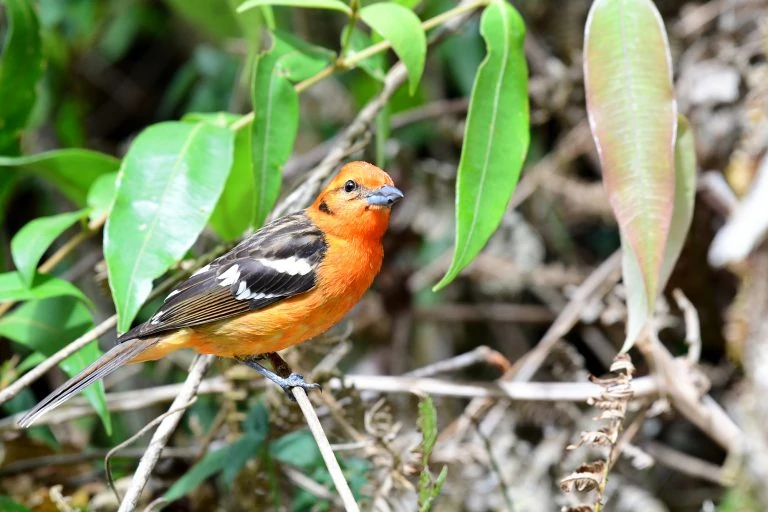
Male Flame-colored Tanagers are brightly colored birds with orange-red coloring, with darker wings and tails. Females are more yellow-orange.
- Length 7 – 7.5 inches (18 – 19 cm)
- Weight 1.13 – 1.71 oz (32 – 48 g).
A rare visitor to the US, the Flame-colored Tanager, has started breeding in Arizona and has been spotted in Texas. They usually inhabit woodland in Mexico and Central America. Their diet is insects and berries.
9. Varied Thrush
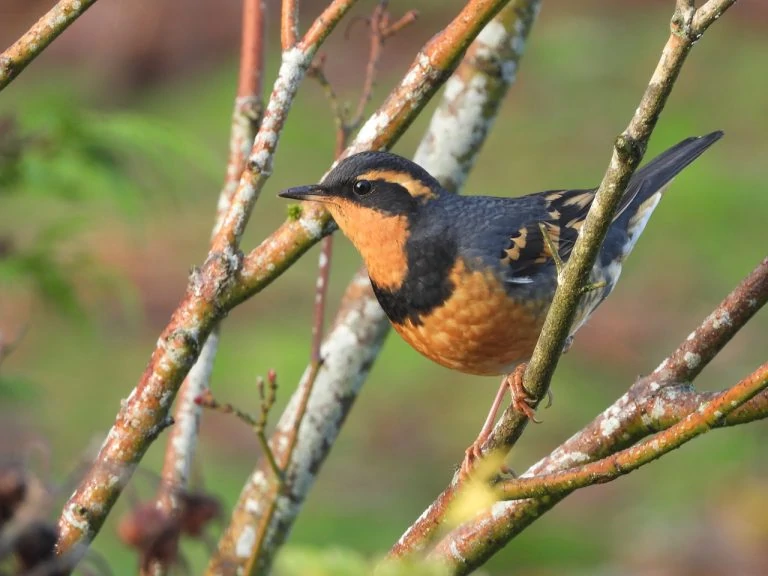
Varied Thrush males are birds with orange breasts and throats and black backs and with a black ‘necklace’ around the throat. The males also have orange bars on the wings and orange stripes on the sides of their black heads. Females are paler and have more brown tones on the back.
- Length: 7.5-10.2 in (19-26 cm)
- Weight: 2.3-3.5 oz (65-100 g)
- Wingspan: 13.4-15.0 in (34-38 cm)
Varied Thrush can be found along the Pacific Coast and Breed in Alaska and Northwestern Canada. Some remain all year in British Columbia and Northwestern US states along the coast. In winter, birds from Alaska and inland in Canada move south as far as California.
They are shy birds that hide in the forest looking for insects in the summer and berries and seeds in the winter.

